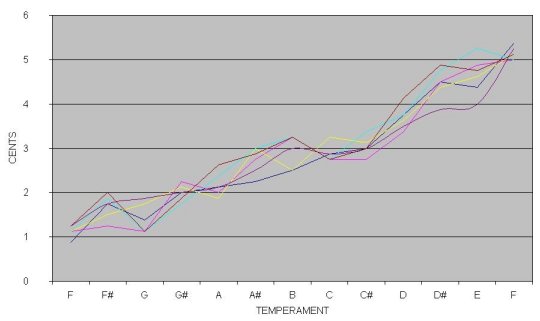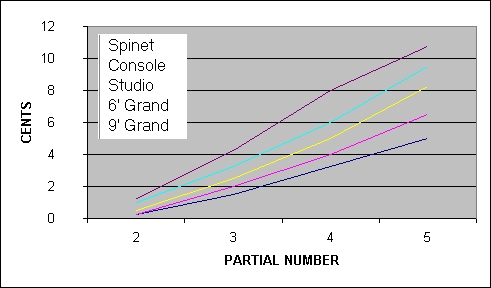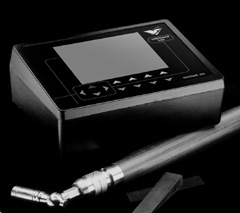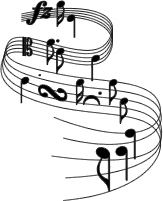K
E N F O S T E R , BM, RPT
P I A
N O T U N I N G S E R V I C E S
w w w . K e n F
o s t e
r . c o m
(801)255-TUNE
SUPER TUNING
using the
most advanced
computer technology available
with
continued aural
checks done by ear
Because of
the inherent
imperfections in all pianos, including variations in string
manufacturing,
cabinet, iron plate, bridges, ribs, soundboard, pinblock, etc., no two
pianos are exactly alike. Every string produces its own unique
characteristics
in tone.
| When
a string is hit and
begins to vibrate, what you see is massive movement throughout the
length
of the string. In reality however, the string has been
mathematically
divided into several sections. These sub-divisions are referred
to
as "overtones". |

Overtone
Divisions:
When
a wire or sound waves
vibrate, it subdivides into simultaneously vibrating fractions referred
to as Partials, or Overtones.
|
|
The first
vibration is called
the Fundamental, or 1st
Partial. This is the actual sound
that
you initially perceive. For example, if the string is tuned to a
"C", you will hear a "C". In actuality, you are really hearing
several
pitches at once. These are the divisions that are occurring
within
the string. The following diagram shows how this division
works:

Divisions
of a vibrating
string generating individual audible pitches,
called
Partials or Overtones.
 (listen ~ click
here)
(listen ~ click
here)
(listen ~ mp3)
|
|
The first division
then, is much like taking your finger and placing it exactly half way
in
the middle of the string. Because the string is now half the
size,
you will hear a pitch exactly one octave higher (from the initial "C"
to
the next higher "C"). This is natures 1st
Overtone, or 2nd
Partial. |
If you had a
"perfect" piano,
the strings would subdivide into these various harmonics making
tuning a breeze. Unfortunately, this is never the case. The
deviations from the perfect divisions is termed inharmonicity.
 Six
different brand
new pianos of the same make and model were measured for the amount of
inharmonicity
in the temperament notes (F below middle C to the F above) using just
the
fourth partial. These variations would cause some significant
challenges
in tuning using a "one size fits all" approach.
Six
different brand
new pianos of the same make and model were measured for the amount of
inharmonicity
in the temperament notes (F below middle C to the F above) using just
the
fourth partial. These variations would cause some significant
challenges
in tuning using a "one size fits all" approach.
|
 This
diagram shows
inharmonicity measurements of just "middle C" between different
types
and sizes of pianos.
This
diagram shows
inharmonicity measurements of just "middle C" between different
types
and sizes of pianos.
|
Through the
use of advanced
computer technology every string is measured for inharmonicity.
These
variations, or deviations from the theoretical partials are then
plotted
and measured against other notes and partials. The computer then
simultaneously tunes up to 8 partials at once, continually
measuring
each partials inharmonicity, relative strength and weakness.
Targets
are then calculated based on the measured inharmonicity, stretch
choices
(Style), temperament, and on the targets of other previously calculated
targets.
 |

The
computer system that
has been helping me achieve these incredible results, calculates nearly
2,000 measurements, individualizing each pianos temperament with
absolute
precision. |
A typical
aural tuner (including myself), and
less sophisticated electronic tuning machines only listen for one
partial
at a time. This requires some guess work on trying to find the
perfect
"stretch" (variations from the theoretical) for a piano.
Consistent
optimize tunings are achieved and refined each time your piano is
tuned.
Partly because of the tremendous amount of information that is kept on
file for your piano. Future tunings are even better, because of
the
stored memory of each strings partials.
| With
continual aural checks
done by ear and the accuracy of the most advanced dedicated computer
system
available,
I am able to produce exceptionally smooth rising beat rates in Equal
Temperament.
Irregularities are easily compensated without guesswork.
Spinets
and other difficult
scales can be tuned with the best possible regularity. Concert
tunings
are done with the type of precision that professional pianists expect
and
require.
Note: Sometimes I am asked if I
tune by ear or with a machine.. the answer is yes to both questions.
I know the very best and latest techniques and systems for
tuning by
ear, I have studied and perfected the only system that is taught and
endorsed by the Guild with the man who has been credited with
co-writing and perfecting this system.
If
done right, tuning is a combination of accuracy and musicality.
Knowing the skills to tune by ear to within 1 cent (one one-hundreth of a half step) helps guarantee a
beautifully sounding piano.
This
was also necessary in order to pass the rigorous examinations of the
Piano Technicians Guild and be granted the credential of Registered Piano Technician (RPT).
|
  |

|


